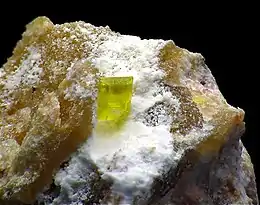Saleeite
Saleeite is a secondary uranium mineral occurring in the oxidized zones of uranium deposits, or as disseminations in carnotite-bearing sandstones. Its chemical formula is Mg(UO2)2(PO4)2·10(H2O).
| Saleeite | |
|---|---|
 | |
| General | |
| Category | Phosphate minerals |
| Formula (repeating unit) | Mg(UO2)2(PO4)2·10(H2O) |
| Strunz classification | 08.EB.05 |
| Crystal system | Monoclinic |
| Space group | Monoclinic 2/m |
| Unit cell | a = 6.951(3) Å, b = 19.947(8) Å, c = 9.896(4) Å, β = 135.17(2)°; Z=2 |
| Identification | |
| Color | Lemon-yellow, straw-yellow, greenish yellow |
| Crystal habit | Crystals are square plates, composite, flattened on {001}, with {001}, {100}, {120}, {012} (pseudotetragonal indices), to 2.5 cm; commonly in subparallel lamellar aggregates. |
| Cleavage | On {001}, perfect; on {010}, {110}, indistinct |
| Luster | Adamantine to waxy |
| Diaphaneity | Transparent to opaque |
| Specific gravity | 3.27 |
| Optical properties | Biaxial (-) typically nearly uniaxial |
| Refractive index | nα = 1.554 - 1.559 nβ = 1.570 - 1.582 nγ = 1.571 - 1.585 |
| Birefringence | δ = 0.027 |
| Pleochroism | X = colorless; Z = pale greenish yellow |
| 2V angle | 2V(meas.) = 0–61° |
| Ultraviolet fluorescence | fluoresces bright lemon-yellow under LW UV, pale yellow under SW UV |
| Other characteristics | |
| References | [1][2][3][4] |
It was discovered in 1932 at Shinkolobwe, Katanga Province, Democratic Republic of the Congo, and is named for Belgian mineralogist Achille Salée (1883-1932), Professor at Université catholique de Louvain, Belgium. It was later determined that the Katanga mineral was meta-saleeite Mg(UO2)2(PO4)2·8(H2O) and the type locality was assigned to the Weißer Hirsch Mine, Neustädtel, Schneeberg District, Erzgebirge, Saxony, Germany.[5][2]
References
This article is issued from Wikipedia. The text is licensed under Creative Commons - Attribution - Sharealike. Additional terms may apply for the media files.